Executive Summary
The Royal Agriculture Society of Victoria (RASV) promotes agricultural production in Australia. The organization plans the Melbourne Royal Show that brings together farmers and all stakeholders in the agricultural and Australian economic sectors. This year, the event is scheduled to take place between 22nd September and 2nd October. Although the preparations are underway, some major and critical issues are identified. First, the event’s location has a limited population capacity. Second, the event’s timelines are short, making it difficult for effective preparations. Third, the organization is overdependent on the event’s income to fund its activities. Therefore, seeking an alternative venue and resource mobilization opportunities is beneficial. Additionally, the allocation of sufficient time for future events will help overcome challenges associated with short notice. This report will offer a comprehensive summary of Melbourne Royal Show preparations, including timelines and resources needed.
Introduction
Project Overview
Agricultural production plays a significant role in the economic growth of Australian society. The Royal Agriculture Society of Victoria (RASV) is one of the leading agricultural promotion organizations in Australia. The organization was founded in 1848 upon the realization of the importance of contests and competition in furthering Australia’s primary production. Consequently, the Melbourne Royal Show occurs every September to celebrate agricultural production and cultivation events, and strengthen communities. The participants get an opportunity to learn about sustainable farming activities and promote their agricultural production. Additionally, the show allows policymakers to identify gaps in the Australian production sector. Therefore, the Melbourne Royal Show is crucial for the agricultural production and promotion of the Australian economy.
Vision and mission statements are important for any event and allow the event planners to track their event’s performance. The statements play three major significant roles: communicate the organization’s purpose to stakeholders, inform development strategies, and develop organizational measurable goals and strategies to gauge success (Toh et al., 2021). Therefore, this show has the vision to be globally recognized and highly valued. Meanwhile, the event’s mission is to connect and engage consumers and generate direct sales. This year, 2022, the event will take place from 22nd September to 2nd October. The Melbourne Showgrounds will host the event with about 500, 000 participants expected to benefit from the show. The Melbourne Royal Show will offer farmers and other stakeholders an opportunity to network with clients and agricultural investors.
Report Contents
Project and event report is significant in tracking preparations for a particular event. This report consolidates all the activities and resources required for a successful Melbourne Royal Show. The report will be divided into nine sections: project scope, stakeholders management plan, marketing, logistics, project budget, work breakdown structure, Gantt chart, risk management plan, and staging and close down. Each section will explore a particular event’s activity for a successful day. Therefore, this report will be used as reference material in ensuring that everything is set ahead of the greatest of all Australian agricultural shows.
Project Scope
Related Activities
Melbourne Royal Show will allow various activities that promote agricultural production and promotion in Australia. Therefore, the Show will include a variety of activities that will help farmers connect with consumers. Contests and competitions will involve participants who are actively engaged in the agricultural revolution. The contestants will showcase their inventions in the field of agriculture. Additionally, the farmers will display their products to attract consumers and investors who are crucial for agricultural promotion. Meanwhile, live music from celebrated Australian and global artists will entertain the participants. Figure 1 provides summary of all activities and resources needed for the project. The Melbourne Royal Show will be engaging and entertaining.
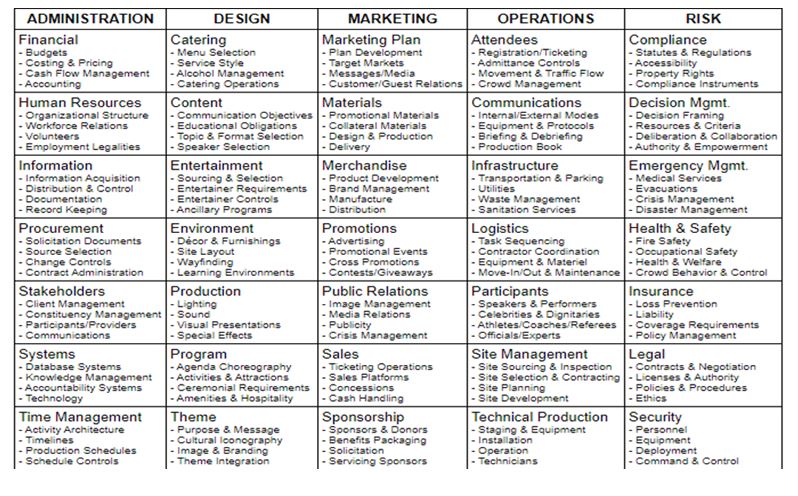
Resources
A successful event involves sufficient resources that help meet stakeholders’ expectations. The primary resource is financial stimulation that will be provided by the event’s partner companies. Additionally, some of the participants are expected to contribute to the event’s finances through chargeable fees for their participation. Technically, the Show will require effective communication and event planning systems that will integrate modern technology. The human resource will be crucial in preparing the event’s logistics and ensuring that everything is in order. The event’s management team is responsible for ensuring that all the resources are secured before the Show.
Timelines and Deliverables
Although the event is scheduled to take place between 22nd September and 2nd October 2022, various milestones must be achieved before then. By 14th September 2022, all the stakeholders will have received the invitation letters. Prioritized stakeholders are the government, financial institutions, and private sectors interested in the Australian agricultural sector. By 15th September 2022, the farmers and small business owners must have received and communicated back their attendance at the event. By 18th September, the management will have all the event fees paid to relevant authorities. Finally, by 20th September 2022, all the technical resources will have been delivered at the event’s showground, including the public address system. The event must be ready to start on 21st September 2022.
Project Limitations
Manpower
The Melbourne Royal Show is expected to attract about 500, 000 participants. Therefore, huge manpower will be required to ensure the event is successful. The event will require strict security operations to ensure that the participants are safe. Additionally, during the event, a big technical support team will be required to ensure that all is in order. However, the available human resource is limited. Additionally, the manpower lacks sufficient organizational skills due to limited preparation time. Although the limited manpower may lead to the event’s failure, the planners ensured that the recruits have sufficient work experience.
Finance
Sufficient finances are crucial for a successful event since all the required resources can be acquired. The Melbourne Royal Show involves a flurry of activities that require heavy financial resources. Although the planning committee have conducted many similar shows, the Royal Show requires a sophisticated technological system to ensure that every planned activity takes place. The event is hugely dependent on well-wishers who may fail to fund the activities. Furthermore, the amount set to be paid by some of the participants is not sufficient to pay for services such as security, medical, and awards to winners. The exhibited financial limitations call for a resource mobilization strategy.
Location
The Melbourne Royal Show will take place at the Melbourne Showgrounds: Epsom Road, Ascot Vale, and VIC. However, the location has various limitations since the event is attractive to the global community. First, the location has limited space, a capacity of about 4, 300 people, for the event’s agricultural activities such as the display of machines and some agricultural technology from all the participants (RASV, 2021). Second, the available security within the area may not ensure the safety of all the participants. Finally, the showgrounds lack enough parking space for the more than 20, 000 participants expected per day. Therefore, the management committee will have to seek other alternatives in ensuring that the available limited space accommodates most of the activities.
Stakeholder Management Plan
Internal Stakeholders
Internal stakeholders will help in the execution of various event-related activities. The internal stakeholders include every person whose interest in an organization comes through a direct relationship such as employment and investment, among others (Pfajfar et al., 2022). The stakeholders include host organization, sponsors, and co-workers. The host organization, RASV, will take part in event planning and ensuring that all required resources are mobilized. The RASV employees and co-workers will monitor the daily activities of the event. Meanwhile, the sponsors who have direct contracts with RASV, and will secure and fund activities such as awarding the winners. The list of the internal stakeholders is shown in Figure 2.
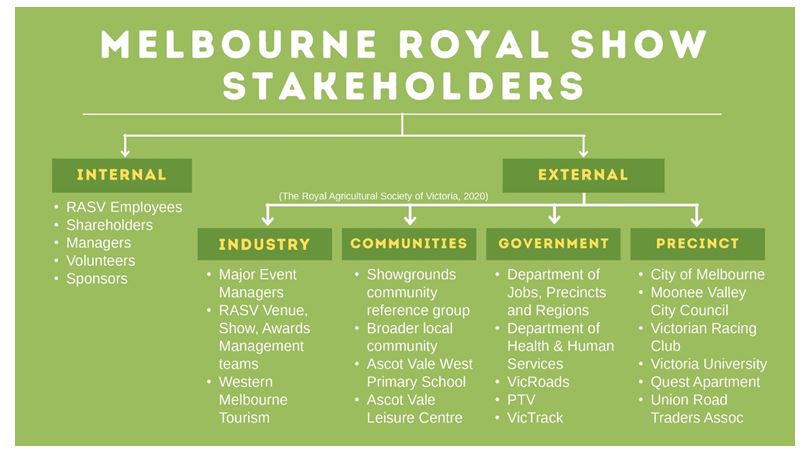
External Stakeholders
While the internal stakeholders play a crucial role in a successful event, the external stakeholders will help in resource mobilization. The external stakeholders are those without a direct relationship with RASV. Some of the stakeholders include spectators, participants, host community, and media that will help in the execution of auxiliary activities. While the media will publicize the event, the spectators will help increase the income by purchasing the event’s tickets and paying entrance fees. The host community will help in offering auxiliary services such as accommodation of participants. The invited participants will pay registration fees that will help for smooth running of the event. Figure 2 shows the list of all the external stakeholders involved in the planning and execution of the event.
Stakeholders Engagement
While all the stakeholders have a defined role to play, engaging them throughout the event can be more beneficial. Consequently, the stakeholder management plan adopts a four-dimensional framework: stakeholder identification, planning, management, and controlling. While the identification involves the identification of the influential stakeholders, the planning identifies mechanisms and strategies to maximize the stakeholders’ support. Meanwhile, the stakeholders’ control is significant in monitoring their involvement before, during, and after the event.
Marketing, Logistics, and Budget
Marketing
Channels Communication Mix
Integration of marketing communication mix would help reach out to a larger audience. The event will utilize various marketing media to reach a larger audience (Mason et al., 2021). Therefore, various tools are adapted to communicate with the stakeholders, Figure 8 shows a sample poster. The social media platforms will be used to engage Australians and other interested parties on the importance of agriculture to the country. The platforms to be used include Twitter, Facebook, and TikTok, YouTube, among others. Additionally, the society involves direct sales representatives who will approach the most influential stakeholders. Furthermore, the mainstream media, radio and television stations, will help in reaching out to the public. This year the event integrates communication technology into the marketing activities as shown in Figure 3.

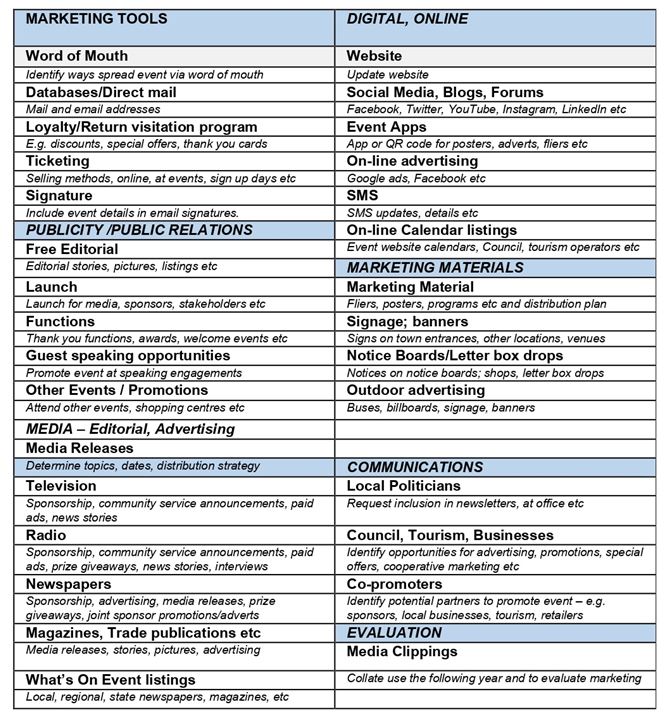
Promotional Activities
An effective marketing plan includes promotional activities that attract many stakeholders. Consequently, various promotional activities will take place before and during the event. First, social media platforms will be used to popularize the event’s central theme. The organization will use influential people such as Australian artists to attract the public. Additionally, promotional merchandise will be used to attract more donors. The participants will be required to purchase the event’s branded merchandise such as t-shirts, car stickers, and banners, among others. Finally, virtual agricultural discussions and interviews in the mainstream media are crucial in engaging the non-participants. Therefore, social media campaigns, selling branded merchandise, and virtual public discussions are crucial in promoting the event.
Target Audience
The agricultural event targets various stakeholders in various sectors that are crucial to the Australian economy. According to the report by the Department of Agriculture, Water and Environment, the country established about 87, 800 agricultural businesses with an Estimated Value of Agricultural Operations of $40, 000 or more between 2019 and 2020 (ABARES Insights, 2022). Therefore, the farmers and agricultural business owners are the prioritized audience. Additionally, the marketing campaign targets students, and technocrats, among other stakeholders who are crucial for Australian economic growth. The targeted audience will be involved through the selected marketing communication tools.
Logistics
Melbourne Royal Show will involve complex and tasking activities for its success. An event’s logistics involve the planning and management of technical and other services to ensure seamless event execution (Ma & Rong, 2021). The management has divided the logistics into three major categories: supply, information, and transport as shown in Figure 7. An organized logistics plan is significant for achieving short-term and long-term goals. Additionally, the plan helps in the optimization and meeting of the participants’ needs. Each of the four logistical activities will involve various actions from the event planners.
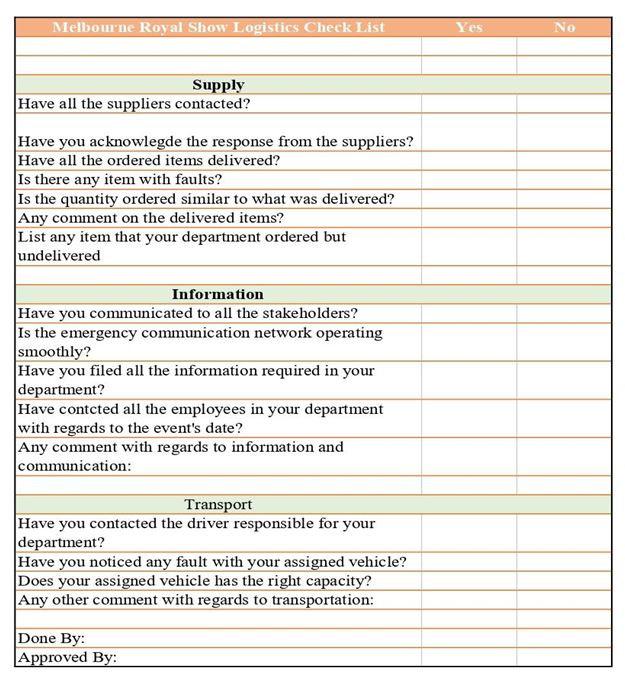
Supply
The event’s supply includes all the resources needed before, during, and after the event. The planners adopted a list of all the supplies required: tents, merchandise, a public address system, and agricultural product samples, among others. Each of the supplies has a set deadline that the stakeholders must have delivered. The event’s Gantt Chart will be used to track progress from the suppliers. The internal stakeholders have the responsibility of ensuring that the supplies are paid for and meet the event’s objectives.
Information
Information is crucial for this event since it involves participants from all corners of the world. The event will adopt a single communication channel that would allow the stakeholders to get clarity if needed. Communications to the most influential stakeholders will have a specific timeline. The information before, during, and after the event will be sent through the organization’s primary e-mail. Meanwhile, emergency communication will be through direct mobile calls with the involved stakeholders. RASV treats information as significant because it helps in tracking the event’s progress.
Transport
Transportation ensures that supplies and human resources are delivered to the event on time. Since the event attracts about 500, 000 participants, it will take place in sessions. RASV transportation team will ensure that all the items relevant to a particular session are delivered at the venue. Additionally, all the internal stakeholders will use RASV vehicles for ease of supervision. Meanwhile, the logistics officer has the responsibility of tracking all the items that are transported to the venue. Although the transportation activities will be conducted by RASV, the external stakeholders will be in charge of transporting their items to the venue.
Project Budget
Fiscal resources are required for the effective execution of the Melbourne Royal Show. The internal stakeholders including the employee need to be paid upon service delivery. Additionally, the suppliers need their supplies to be paid for. An effective and accurate budget helps in avoiding mishaps associated with non-payment of services and supplies delivered. The event has an estimated expense of $31, 705, 000. Meanwhile, the estimated income from the event’s participants among other external stakeholders is $33, 784, 000. The estimated budget is based on the projections of similar events in 2019 and 2018 (RASV, 2019). Figure 4 provides the budget breakdown of the income and expenses.
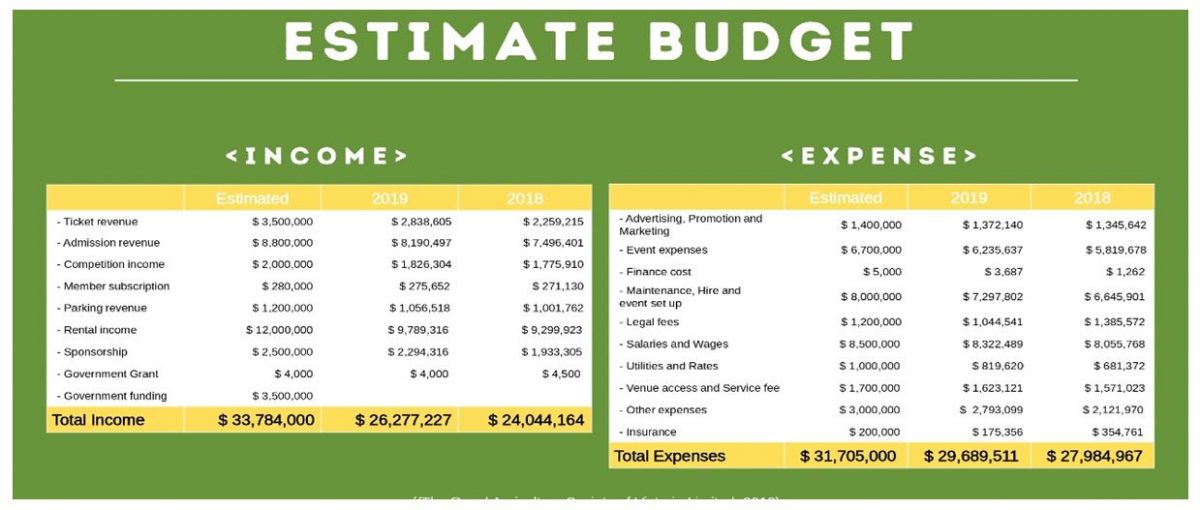
Activities’ Organization
Work Breakdown Structure (WBS)
Melbourne Royal Show event will involve various activities and tasks. The activities will be divided into three major categories: pre-event, during the event, and post-event. The pre-event activities are that will take place before the actual event. Some of the ‘pre-event’ activities include communicating with stakeholders, marketing, tendering process for the supplies, and the creation of working contracts, among others. The ‘during the event’ activities are those that will take place as the event progresses. Some of the ‘during the event activities’ include welcoming the participants, displaying various products, and competitions, and awarding the winners, among others. Meanwhile, the ‘post-event’ activities will take place after the event. The major ‘post-event’ activity is follow-ups on stakeholders, budget consolidation, and making payments, among others. Figure 5 summarizes all the activities intended to take place at Melbourne Royal Show.

Gantt Chart
Melbourne Royal Show has strict deadlines that must be met by the stakeholders. While the WBS summarizes all the activities in an orderly manner, the Gantt Chart helps the team involved to plan work around deadlines and properly allocate resources (Ma & Rong, 2021). Therefore, the chart will help the RASV management maintain a bird’s eye view of the project. The Gantt Chart’s baseline will help in taking a snapshot of the event’s positions of stakeholders, and milestones, among other involved parties (Brokman-Meltzer et al., 2021). Figure 6 presents a Gantt Chart for all the activities conducted in preparation for the Show.
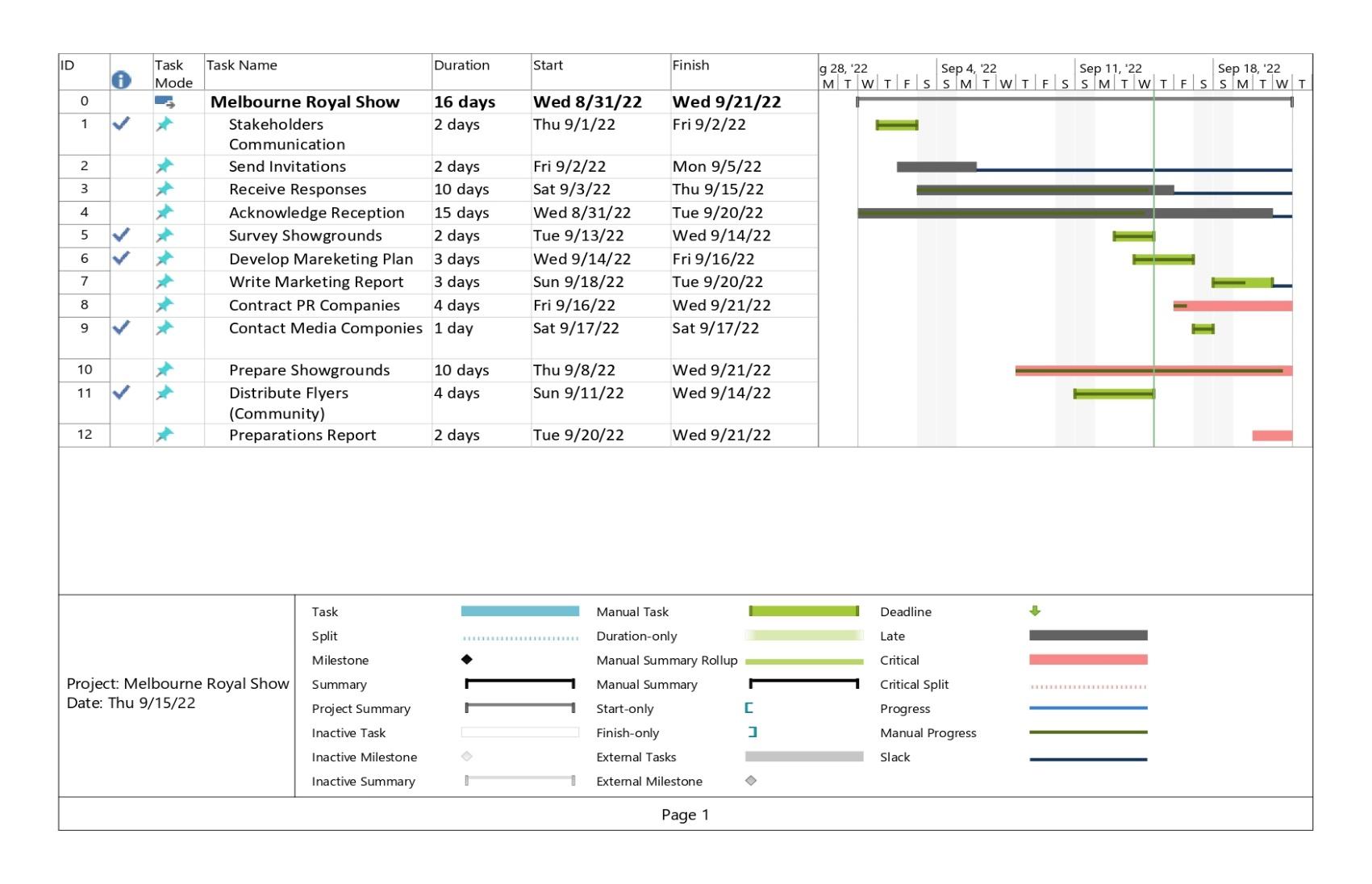
Risk Management Plan
Melbourne Royal Show is subject to various risks due to the overarching limitations. For instance, the absence of sufficient manpower can potentially lead to disorganization in the course of the event. Additionally, the limited event budget has led to exclusion of important supplies that could make the event flow smoothly. An automated and digitized project management system would make it easier for the stakeholders to track every activity limiting the possibility of losses. Therefore, a risk management plan can help track and attend to any risk identified in the course of the event. The plan will integrate strategies that allow the implementation of solutions identified during the event. A risk management plan ensures maximum benefits of the event, through step-by-step risk identification and response.
The plan will involve three important procedures of risk management: identification, analysis, response planning, and monitoring. Risk identification involves the preliminary steps taken by stakeholders to recognize possible risks. The identification process will involve the utilization of the project’s objectives and timelines. The risk analysis process will involve a deeper understanding of the identified risks and their impact on the event. Qualitative and quantitative analysis reports will be made. Meanwhile, risk response planning involves the stakeholders’ initiative to address the identified mishaps. While some of the responses may be immediate, others can be consolidated for future reference. Risk monitoring enables the stakeholders to control the risks’ impact on the event, and give a final report on the same.
Staging and Close-Down Sequences
Staging
The event is scheduled to start on 22nd September 2022. The staging process incorporates all event aspects that enable performance to take place. A specific sequence will be adopted during the staging of the event. First, the internal stakeholders will demarcate areas where the participants will be accommodated during the event. Additionally, the contracted companies will help in setting up the main event’s dais. Second, the participants will be taken through RASV and its successful shows in the past. Third, the organization’s executive leadership will welcome the participants. Finally, a special guest from the government will declare the event open, allowing the participants to take part in their respective activities and competitions.
Closing Down
The closing of the event will take place on 2nd October 2022. The closure follows the successful completion of all the competitions and exhibitions. The closing down procedure follows specific steps involving all the stakeholders. The overall event manager will receive notification of the end of competitions from the supervisors. Additionally, reports from other activities will be given to the manager. Upon receiving all the reports, the manager will notify the RASV executive leadership who will approve an order for all the participants to convene at the main dais. Thereafter, the executive leadership will award various winners, and give a vote of thanks to all the participants. Feedback questionnaires will be distributed among the participants.
Conclusion
Main Findings
In the course of planning the Melbourne Royal Show, various issues were identified. First, the provided timeline was short, making it difficult to prepare all the required resources. Secondly, the event is mainly dependent on the income from the event’s activities and donors. Therefore, the limited budget encumbered the delivery of crucial services such as the adoption of a digitized project management system. Third, the chosen venue has a limited population capacity, making it difficult to accommodate all the expected participants. Although Melbourne Royal Show’s preparations were strategic, the limitations interfered with its success.
Implications
The identified finds would impact the event in various ways. The limited space is disastrous to the planned activities such as exhibitions, event staging and closing down, among others. Meanwhile, the strict timelines are subject to inconsistent output among the stakeholders. For instance, donors need enough time to process and approve financial assistance requests. Furthermore, the absence of dependable software to manage all activities leads to over-dependence on the human brain which is subject to mistakes. Therefore, RASV can adopt various strategies to address the main findings.
Recommendations
RASV could have taken various steps to avoid the existing limitations. First, sufficient time should be allocated to the preparations and planning. Consequently, the involved stakeholders would have enough time to respond and deliver resources. Second, the organization could expand its funding activities to increase its income. Applying for grants from the government could boost the event. Additionally, utilization of stakeholders’ knowledge could help save on the budget. For instance, technical universities could be invited to help in the designing of event management software. Finally, seeking an alternative and bigger ground could help accommodate the many participants. Addressing the identified issues would be beneficial to the organization and its stakeholders during the event.
References
ABARES Insights. (2022). Snapshot of Australian agriculture. ABARES. Web.
Brokman-Meltzer, M., Perez, D., & Gelbard, R. (2021). The perceived complexity of a project’s optimal work plan influences its likelihood of adoption by project managers. Project Management Journal, 52(5).
Ma, Y., & Rong, Y. (2021). Project planning and management. Senior Design Projects in Mechanical Engineering, pp. 329–344.
Mason, A. N., Narcum, J., & Mason, K. (2021). Social media marketing gained importance after Covid-19. Cogent Business & Management, 8(1), pp. 1870797.
Pfajfar, G., Shoham, A., Małecka, A., & Zalaznik, M. (2022). Value of corporate social responsibility for multiple stakeholders and social impact – Relationship marketing perspective. Journal of Business Research, 143, pp. 46–61.
RASV. (2019). Annual report 2019. Web.
Toh, S.-Y., Tehseen, S., Mahmoud, A. B., Cheok, J., Grigoriou, N., & Opute, J. (2021). Mission statement effectiveness: investigating managers’ sensemaking role. Corporate Communications: An International Journal, 27(2), pp. 329- 345.